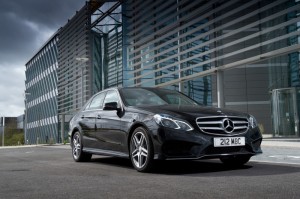
The following technical report on the Mecedes-Benz hybrid explains the key features and technology as can be found in their latest hybrid car, the Mecedes-Benz E 300 BlueTEC Hybrid.
The same engine from the E 250 CDI also features at the heart of the E 300 BlueTEC Hybrid, with a diesel electric powertrain combined to give the best of both worlds. Its CO2 emissions are on the low side at 109-110 g/km, as low as found in the former E-Class, but these emissions can now be achieved on 17-inch wheels where previously this was only possible on 16-inch wheels.
The car features a modular hybrid powertrain with lithium-ion battery delivering class-leading efficiency thanks to its diesel-electric powertrain with an all-electric drive mode, ECO start/stop, brake energy recuperation, boost effect and ‘sailing’ (see below for description).
The four-cylinder diesel engine is rated at 204 hp and 500 Nm, while the electric motor has outputs of 27 hp and 250 Nm. The E 300 BlueTEC Hybrid is part of the Mercedes-Benz intelligent downsizing strategy, which aims to deliver the best possible efficiency in everyday use rather than purely on official test cycles. The body, interior and boot required no modifications to house the electric drive components. The 0-62 mph acceleration time is 7.5 seconds while the top speed is 150 mph – and all from a car capable of an official 68.9 mpg!
The hybrid system also adds to driving comfort with the E 300 BlueTEC Hybrid moving off from standstill in an eery virtual silence powered by the electric motor alone and with dampening of any internal combustion vibrations.
The diesel engine switches off when coasting at speeds of up to 100 mph (sailing), and at the same time brake energy is recovered. The electrically controlled steering, brakes, and refrigerant compressor continue to function normally. Manoeuvring, parking and setting off at modest loads are normally conducted under all-electric power taking advantage of the electric motor’s instantly available torque. The electric motor assists the diesel engine during harder acceleration where needed, in effect boosting the natural torque output of the piston engine. The central display provides information on energy flow and battery charge status.
A wet clutch transmission similar to the one found in high-performance AMG models allows the electric motor to be integrated into the gearbox itself, so that it takes up only marginally more space (65 mm) than the normal 7G-Tronic Plus gearbox unit. The omission of a regular torque converter permits sailing.
Electrical energy comes from a 19 kW lithium-ion battery with an energy content of 0.8 kWh, allowing the E 300 BlueTEC Hybrid to run purely on electrical power at speeds of up to 19 mph for up to two-thirds of a mile. This is mounted under the bonnet in place of a conventional battery, while the other hybrid-specific components are integrated directly with the diesel engine.
Source; Mercedes-Benz
